

Click on a photo to see a bigger one
By Chuck DuVivier
I have some experience with pigs, having raised about one thousand a year when I was younger. In a community of subsistence farming, hog rearing offers lots of possibilities. Farmers with better education, observation and management skills can work with the breeding sows and produce 8 week old, 20kg feeder pigs in an intensive farrowing operation. Success is measured by the number of healthy pigs produced per sow per year but a farmer needs knowledge of breeding, feeding, housing, disease management and much more. A farrowing operation needs to have access to capital for equipment and housing, feed and breeding stock. If an area has a source of well-bred, healthy, feeder pigs, then there is an opportunity for others to do the less intensive enterprise of hog feeding. Hog feeders can utilize whatever low cost feed that is available as long as they supplement to provide a balanced diet needed for fast growth. A hog feeding operation can be as large as one can manage or as small as one pig at a time and this allows people with very limited assets to participate.
 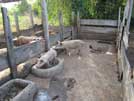
|
People are fired up now. At yesterday's community meeting, I was invited to visit and consult with individuals at their farms or places of business. Actually, the head of the Rotary Community Corp took the floor to say they expected me to consult with them ALL and assigned appointments for me for the rest of the week. Before I came to Uganda, I had determined that individual farm visits should be my starting point for getting to know the issues better. That would have required that I have a vehicle and translator at my disposal all the time, which is not the case. Instead, we had many "meet the community" opportunities which are important but take time, are generally educational but can never be in-depth enough to actually base an action or management strategy on. Well today, I hit the ground running with five farm visits scheduled (only four of which we had time for). I am getting to see things now, crops in the field, animals up close, crops growing well and others damaged by blight, virus, drouth or weeds. We spend time talking about how each farmer is running his operation, and because it is one-on-one, the conversation is very open and I can ask just about any question I want to and get an honest reply. They know how they live, they know when they have cut corners and lost production because of it. They let me see their latrines, kitchens and bedrooms. They admit that they have lost animals or crops and felt helpless but knew they had to go on. They ask questions and I answer when I can, but I admit it when I can't.
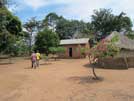 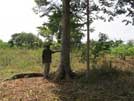 
|
One disadvantage to their system is how small scale it is. The low volume of logs to cut makes finding a buyer who is willing to pay decent prices almost impossible. I am sure that prices would be higher and more buyers would appear if enough farmers could adopt this method to produce a greater volume of these straight-grained, fine looking logs.
The elderly Musizi tree gardeners also presented me with a nice chicken, my first African consulting fee!
Members of the Kampala North RC had arrived and we returned for meetings and another community meeting at the school. All of our meetings are scheduled with a sliding time-frame, such as "two-for-two-thirty" which really means "two-forty-five or three, more or less." Sometimes it is frustrating when you are there on time and just have to wait and then later on you are pushed to hurry up and go because time is up. The group from Kampala brought Dr. Julius Wambete from the University of Makarere with them. He is working on a year old graduate program that is attempting to take agriculture/food processing/business students, provide them with a food processing lab, equipment and training in business product development which should then produce graduates who have a researched product and the skill to manage a business based on it. We had Julius speak briefly about product development and the concept adding value to products.
 Today Fred took the health-oriented part of our group off to visit the hospital, so Patrick and I were forced to improvise. We had been assigned six business and farm visits spread from nearby to the far end of Iringa Parish so the boda-boda (motorcycle taxi) was our only option. Having witnessed local boda-boda madness I wasn't sure I wanted to be a passenger. A boda-boda would be fine but I am an avid motorcyclist and I insisted that I ride my own. Ten minutes later, two riders arrived, the fee was negotiated ($8 all day with drivers) and we headed to our visit with me on the back to start out.
Today Fred took the health-oriented part of our group off to visit the hospital, so Patrick and I were forced to improvise. We had been assigned six business and farm visits spread from nearby to the far end of Iringa Parish so the boda-boda (motorcycle taxi) was our only option. Having witnessed local boda-boda madness I wasn't sure I wanted to be a passenger. A boda-boda would be fine but I am an avid motorcyclist and I insisted that I ride my own. Ten minutes later, two riders arrived, the fee was negotiated ($8 all day with drivers) and we headed to our visit with me on the back to start out.
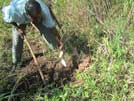 Stop one was to visit a pretty good, crop-focused farmer and I had him demonstrate the method of hand-hoe digging used to harvest cassava tubers. He had harvested some of his large cassava field earlier with good results but we could now see the virus infected tubers rotting away and lowering his harvestable yields. I had been aware of the cassava virus from my research years ago and had heard that Uganda had developed and switched over to virus-resistant varieties several years back, but here, no one was aware of the issue until maybe six months ago when they started harvesting a were shocked by the rot. Some of the newer propagated plantings still were made with susceptible stock and are sure to be a total loss when harvesting starts 18 months later.
Stop one was to visit a pretty good, crop-focused farmer and I had him demonstrate the method of hand-hoe digging used to harvest cassava tubers. He had harvested some of his large cassava field earlier with good results but we could now see the virus infected tubers rotting away and lowering his harvestable yields. I had been aware of the cassava virus from my research years ago and had heard that Uganda had developed and switched over to virus-resistant varieties several years back, but here, no one was aware of the issue until maybe six months ago when they started harvesting a were shocked by the rot. Some of the newer propagated plantings still were made with susceptible stock and are sure to be a total loss when harvesting starts 18 months later.
Other visits included some farms, confinement poultry projects, a private for-profit school and a beauty "saloon" (salon). The last two were at the Iringa trading center and both look healthy on paper, but owners tend to subsidize their businesses and not keep good records. They seldom know what is really going on and are not sure how to improve their sales or control their costs. Both would benefit from follow up coaching.
 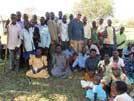
|
We headed back to Iringa trading center to check on the painting at the clinic and then went on single track back trails all the way to Patrick's house. It was a good thing that I was following because I would never have been able to thread my way back on that maze of trails.
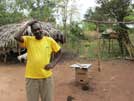 
|
The farmer produced honey and wax but had no market, some small decorative fuel saving stoves which I don't think he had sold, as well as crops. There is a real shortage of cash and selling any product is always a challenge.
 After the community meeting we were told that we had two more farm visits so off we went. Farm one was after a long walk through the brush to a fenced inclosure where the farmer had 25 beehives. Some were Langstrom box hives, the result of a beekeepers' training project, and then some Kenyan box hives. After some research a few months ago, I have been ready to recommend the box hives as a cheaper, more appropriate hive for the area. The beekeeper said the box hives were deficient because the bees did not have enough space and mixed brood cells into the honey storage areas. He was thinking about a queen excluder screen which may work to fix the problem. They also had the same problem as the other beekeepers, no place to sell the honey so they just eat what they produce.
After the community meeting we were told that we had two more farm visits so off we went. Farm one was after a long walk through the brush to a fenced inclosure where the farmer had 25 beehives. Some were Langstrom box hives, the result of a beekeepers' training project, and then some Kenyan box hives. After some research a few months ago, I have been ready to recommend the box hives as a cheaper, more appropriate hive for the area. The beekeeper said the box hives were deficient because the bees did not have enough space and mixed brood cells into the honey storage areas. He was thinking about a queen excluder screen which may work to fix the problem. They also had the same problem as the other beekeepers, no place to sell the honey so they just eat what they produce.
 After visiting the bees, we headed to look at 30 "oak" trees, I am unsure of the species but the owner wants to cut them for logs. Under the trees were sisal gardens, cassava, cotton, and maize, and because the soil was very sandy, they all were getting some benefit from the shade. We didn't have much advice except to say, maybe he shouldn't cut them just yet. Patrick is thinking about a plan to buy timber like that but leave it standing for a personal longer term investment. He will have to work that out. The villagers asked us to see their waterhole which was very unsanitary. There is a borehole for the area, but it pumps only a trickle at certain times of the year, so people won't stand in line and just head for the nasty waterhole.
After visiting the bees, we headed to look at 30 "oak" trees, I am unsure of the species but the owner wants to cut them for logs. Under the trees were sisal gardens, cassava, cotton, and maize, and because the soil was very sandy, they all were getting some benefit from the shade. We didn't have much advice except to say, maybe he shouldn't cut them just yet. Patrick is thinking about a plan to buy timber like that but leave it standing for a personal longer term investment. He will have to work that out. The villagers asked us to see their waterhole which was very unsanitary. There is a borehole for the area, but it pumps only a trickle at certain times of the year, so people won't stand in line and just head for the nasty waterhole.
It had been a long and busy day, but we still took time to visit the clinic, the carpenter who is working on the computer lab furniture, and the community center construction progress before returning after dark to showers, dinner and bed.
Home |
Calendar |
Directory |
Club Information |
Club News |
Yellow Pages |
Speakers Bureau |
Registration |
Quickbits
Newsletter |
Public Relations |
Membership Resources |
Club Service |
Community Service |
Vocational Service
New Generations |
International Service |
Rotary Foundation |
Peace |
Training |
Awards |
Rotary Links |
Archives
